Magazine

Mexico’s Murky Waters
Oceana brings science and transparency to troubled fisheries
Seafloor Victories
Oceana’s trawling wins have protected huge swaths of ocean
Plastic Planet
To fight plastic pollution, you have to go to the source
SUMMER 2019 OCEANA.ORG
Actress Diane Lane joins Oceana to advocate for a ban on the sale of shark fins in the United States.
Board of Directors
Valarie Van Cleave, Chair
Ted Danson, Vice Chair
Diana Thomson, Treasurer
James Sandler, Secretary
Keith Addis, President
Gaz Alazraki
Monique Bär
Herbert M. Bedolfe, III
Sydney Davis
César Gaviria
Mária Eugenia Girón
Loic Gouzer
Jena King
Sara Lowell
Stephen P. McAllister
Dr. Kristian Parker
Dr. Daniel Pauly
David Rockefeller, Jr.
Susan Rockefeller
Simon Sidamon-Eristoff
Heather Stevens
Dr. Rashid Sumaila
Sam Waterston
Jean Weiss
Nicholas Davis
Editorial Staff
Editors
Allison Guy & Emily Petsko
Designers
Karen Radewald & Alan Po
Ocean Council
Susan Rockefeller, Founder
Kelly Hallman, Vice Chair
Dede McMahon, Vice Chair Anonymous
Samantha Bass
John and Violaine Bernbach
Rick Burnes
Marcella Cacci
Vin Cipolla
Barbara Cohn
Ann Colley
Edward Dolman Susanne Elstein
Kay Fernandez
Marsha Garces Williams
Brian and Linda Gold Carolyn Groobey
J. Stephen and Angela Kilcullen
Ann Luskey
Peter Neumeier
Carl and Janet Nolet
Ellie Phipps Price
David Rockefeller, Jr. Andrew Sabin
John and Regina K. Scully Sutton Stracke
Vivien Sylvester
Mia M. Thompson
Dr. David Treadway
Edgar and Sue Wachenheim III
David Max Williamson Raoul Witteveen Leslie Zemeckis
Oceana Staff
Chief Executive Officer Andrew Sharpless
President Jim Simon
Senior Advisor Michael Hirshfield, Ph.D.
Chief Policy Officer, North America Jacqueline Savitz
Chief Scientist Katie Matthews
Executive Director and Vice President, Oceana in Europe Pascale Moehrle,
Senior Vice President, Strategic Initiatives Matthew Littlejohn
Vice President, Belize Janelle Chanona
Executive Director, Oceana Canada Joshua Laughren
Vice President, Mexico Pedro Zapata
Vice President, Peru Patricia Majluf, Ph.D. Vice President, Chile Liesbeth van der Meer
Vice President, Philippines Gloria Estenzo Ramos, J.D. Vice President, Brazil Ademilson Zamboni, Ph.D.
Vice President, Development Nancy Golden
Chief Financial Officer Christopher Sharkey
Deputy Vice President, U.S. Pacific Susan Murray
Cover photo:
©Diane Lane 2019
All Rights Reserved
Photo by Mark Seliger
Makeup by Tim Quinn for Giorgio Armani Beauty
Hair by Ric Pipino
Styling by Diana Melencio
Oceana is published by Oceana Inc. For questions or comments about Oceana, or to subscribe to Oceana, please call our membership department at +1.202.833.3900, e-mail membership@ oceana.org or write Oceana, Member Services, 1025 Connecticut Ave. NW, Suite 200, Washington, DC 20036 USA
Oceana’s Privacy Policy: Your right to privacy is important to Oceana, and we are committed to maintaining your trust. Personal information (such as name, address, phone number, e-mail) includes data that you may have provided to us when making a donation or taking action as a Wavemaker on behalf of the oceans. This personal information is stored in a secure location. For our full privacy policy, please visit Oceana.org/privacypolicy.
Please Recycle.
FSC Logo


Features
To help navigate Oceana’s work, look for these five icons representing our five major campaigns. Curb Pollution Stop Overfishing Reduce Bycatch Mexico’s Murky Waters 12 CEO note Why Samantha Dunn, editor of Orange County Register, is trying to be less plastic For the win Dusky sharks safeguarded, new marine parks in Canada and the UK and more News & notes Offshore drilling delayed in the U.S., illegal anchovies in Peru and more Q&A Valarie Van Cleave and Simon SidamonEristoff Mexico’s murky waters Oceana research aims to
science and transparency
fisheries management Fighting plastic pollution Reycling and cleanups aren’t enough — we have to go after plastic before it’s even made Oceana victories Highlights from Oceana wins in 2018 and 2019 Supporter spotlight Diane Lane to be honored at Oceana’s New York Gala Ask Dr. Pauly What aquaculture can and cannot do Events SeaSong in Mexico City Fin win How Oceana’s advocacy helped restore California’s delicious rockfish Parting shot A mother humpback and her calf in Silver Bank, Dominican Republic 3/ Combating Plastic Pollution 18 4/ 6/ 12/ 8/ 18/ Protect Habitat Increase Transparency 28/ 29/ 30/ 32/ 34/ 36/ © Oceana/Claudio Almarza © Oceana/Melissa Forsyth
Departments
bring
to Mexico’s troubled
Your support makes an ocean of difference
Please Give Generously Today
A healthy, fully restored ocean could sustainably feed more than 1 billion people each day.
Call us today at (202) 833-3900, email us at info@oceana.org, visit www.oceana.org/give or use the envelope provided in this magazine to make a donation. Oceana is a tax-exempt 501(c)3 organization and contributions are taxdeductible to the fullest extent of the law.

© Shutterstock/Davdeka
Dear Reader:
NoteAs I sat down to write to you about our campaign to stop ocean plastic pollution, I read a terrific piece on this problem from Samantha Dunn, editor of Coast Magazine and the Orange County Register. With her generous permission, I’m reprinting it for you here.
Samantha Dunn, July 9, 2019. Reprinted from the Orange County Register.
Sometime in May news broke of how a deep-sea explorer named Victor Vescovo had set a record for plumbing the Earth’s deepest known point, the Pacific Ocean’s Mariana Trench.

There Vescovo laid eyes on five things he never expected to see: four previously unknown species. And one plastic bag.
A plastic bag that has traveled more than 6 miles down to the lowest point of the ocean floor.
I keep thinking about that bag. How long ago did it work its way into the water? I wonder, was it from Ralphs? I ask because I remember using a plastic Ralphs grocery bag to throw away my ex-husband’s socks (long story, I won’t bore you), back in the mid-’90s when we did things like that. I’m talking about using “disposable” plastic bags without a thought, not marrying inappropriate men. (Although we did that, too. Or at least I did.)
And I’m not even going to talk about the epidemic of dead whales, their emaciated bodies washing ashore, filled with plastic. OK, so I just did talk about dead
whales. Turns out Captain Ahab only needed a ship’s cargo of Hefty bags and cartons of plastic water bottles to defeat the mighty creature.
What I’m wrestling with is my unconscious complicity in a global problem that mushrooms minute by minute. The statistics are so staggering they are impossible to wrap your mind around: National Geographic reports that about 18 billion pounds of plastic waste flows into the oceans every year.
What does that even look like?
Oceana, the largest nongovernmental organization fighting for ocean conservancy and restoration around the world, breaks it down for us: That means that every minute of every day a dump truck’s worth of plastic goes into the ocean.
When I read that on the Oceana website, all I could picture were local WM trucks in an endless line up and down Coast Highway, pulling up to Newport Harbor, hydraulics hissing as the trucks spill their loads into the blue water, one right after the other.
I know you, like I, didn’t intend for this to happen. We have just used our Oral-B toothbrushes, our Ziploc baggies, our Evian bottles and oh so many, many more things, without realizing they would last in the world forever, even if
their usefulness to us was only temporary. We were told they could be recycled, and so we dutifully separated them into bins. And yet, it turns out less than 10 percent can be recycled, and the problem is only getting worse. (The OC Register’s Martin Wisckol recently wrote an informative article about this — look it up.)
All this bleak info would be enough to drive me under if I didn’t also see the swell of action happening all around me, the many local efforts like the recent 3rd Annual Newport Harbor Underwater Cleanup at Balboa Bay Club, where divers and shore-side volunteers removed hundreds of pounds of debris from the bay. But now that we all understand better the magnitude of the issue, we know cleaning up is only part of the battle. Coast is proud to once again be the media sponsor for Oceana’s annual SeaChange Party, slated for Sept. 7, which will support a worldwide effort to reduce our dependence on plastics in everyday life.
I love this quote from Oceana’s chief policy officer, Jacqueline Savitz: “When your bathtub is overflowing, you don’t run for a mop before you turn off the faucet. Recycling is the mop. We need to turn off the faucet.”
SUMMER 2019 | Oceana.org3
I’m trying not to be so plastic
Sincerely, Andrew Sharpless, CEO Oceana
For the Win
Oceana wins lawsuit to protect overfished dusky sharks in the US

In March, a struggling shark species got the justice it deserves. A judge ruled that the Trump administration had violated federal law by failing to use all available scientific evidence to end the overfishing of dusky sharks. The ruling, a response to an Oceana lawsuit filed by Earthjustice, will require the federal government to do more to end the rampant overfishing of dusky sharks.
Though the federal government acknowledged that dusky sharks were overfished nearly 20 years ago, it failed to end dusky overfishing immediately, as federal law requires. Since then, dusky numbers have plummeted by at least 65 percent in U.S. Atlantic and Gulf waters, with thousands incidentally killed in fisheries for other species. Dusky sharks grow slowly and have low reproductive rates, making them highly vulnerable to overfishing.
Canada announces 1,000-square-kilometer marine park off Quebec
In March, Fisheries and Oceans Canada (DFO) announced the creation of a new marine protected area on Banc-des-Américains, off Quebec in the Gulf of St. Lawrence. The bank is home to cold-water coral and sponge forests, important food species like crab, shrimp and cod, and iconic wildlife such as the critically endangered North Atlantic right whale.
In 2017, Oceana Canada and DFO partnered to conduct an expedition in the Gulf of St. Lawrence, including the Banc-des-Américains. The expedition’s maps of Banc-des-Américains’ geographic features and its detailed analysis of the bank’s habitats and species will help inform the new protected area’s management and monitoring plans.
4
Dusky sharks have been overfished for nearly 20 years.
With new parks, 40 percent of England’s waters are now protected
In late May, the United Kingdom announced the creation of 41 new marine conservation zones. These zones now cover 40 percent of English waters and 30 percent of UK waters. During the government’s consultation process, Oceana provided relevant data from its 2017 research expedition to the North Sea. The expedition visited five countries, including the UK, to gather scientific measurements, photographs and other information that would make the case for strengthening the North Sea’s network of marine protected areas.
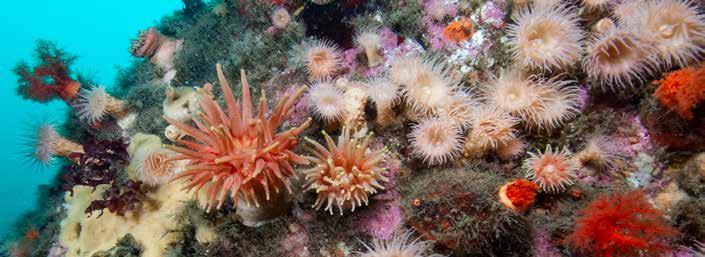
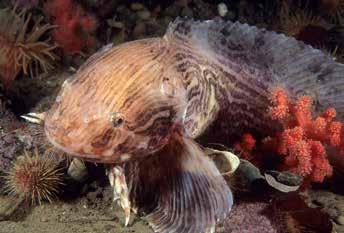

“This decision takes the UK to the top of the leaderboard in terms of marine protection in Europe,” said Pascale Moehrle, the executive director for Oceana in Europe. “But all these sites need to be properly managed, with no bottom trawling allowed,” she added.
Chile ends ocean dumping of toxic mining waste
Tailings, a slurry of rock, chemicals and mud left behind by mining operations, can poison habitats and communities with mercury, arsenic and powerful acids. In Huasco, on the edge of Chile’s Atacama Desert, the mining and steel company CAP has been illegally dumping tailings into the ocean for the last 40 years.
In 2017, Oceana submitted a report to the government detailing the company’s illegal practices, demonstrating that not only had CAP disposed of tailings in the ocean, it didn’t even have permits to dispose of tailings on land.
In 2018, Chile’s Environment Superintendency brought 20 charges against CAP for violating environmental regulations, and in March, the agency ruled that CAP must stop its illegal dumping within four years — a decision that will protect the region’s valuable fish.
SUMMER 2019 | Oceana.org5
Snow crabs are a commercially important species in Canada. Some species of snailfish produce natural antifreeze.
Canada’s Gulf of Saint Lawrence is home to vibrant seafloor habitats.
Notes
UN Environment, Oceana and insurers issue first-ever guidelines to combat pirate fishing
Oceana report finds 31 percent of Mexican seafood is mislabeled Seafood mislabeling, which occurs when one species is accidentally or intentionally substituted for another, is a global concern.

Around the world, around onethird of all seafood is mislabeled — and as a recent Oceana report found, Mexico is no exception.
The report found that 31 percent of almost 400 samples of fish analyzed in restaurants, supermarkets and fish markets in Mexico City, Mazatlán and Cancún were mislabeled. In one of the more egregious examples, all grouper tested in Cancún were actually Asian catfish or other cheap species. Oceana’s study, the first of its kind in Mexico, demonstrates the urgent need for better regulation and supply chain transparency.
Trump administration delays offshore drilling plan
At the end of April, the Trump administration announced a delay in its plan to dramatically expand offshore oil drilling to nearly all U.S. waters. David Bernhardt, the Secretary of the Department of the Interior, cited a recent federal court decision to protect areas of the Arctic and Atlantic oceans from drilling as the reason for the delay.
Oceana and its allies have organized a groundswell of opposition to expanded offshore drilling across the United States. Every governor on the East and West Coast has expressed opposition to or concern over drilling, along with 350 local municipalities, thousands of government officials, and tens of thousands of coastal businesses and fishing families.
“We believe this is a significant factor in the decision to delay,” said Oceana campaign director Diane Hoskins. She added that ocean advocates must remain vigilant as “the delay could end at any time.”
In late February, the United Nations Environment Programme, Oceana and leading insurers issued guidelines designed to enable insurers to flag pirate fishing activity, as part of a global insurance industry effort to curb illegal fishing. The new protocol, a world first, was developed so the insurance industry can better detect illegal fishing and deny insurance to vessels and companies caught or suspected of pirate fishing. Illegal fishing exposes insurers to legal, financial and reputational risks, and costs the global economy between $10 billion and $23.5 billion every year.
Oceana investigation discovers 62 illegal fishmeal facilities in Peru
The Peruvian anchovy is one of the world’s biggest fisheries, with millions of tons of fish caught every year. The vast majority of these anchovies are caught in industrial fisheries and sold to factories to be “reduced” into oil and fishmeal, key ingredients in feed for farmed fish and livestock. Legally, the anchovies that smallscale, artisanal fishers catch can only be sold for human consumption, a rule designed to provide healthy, affordable protein to impoverished Peruvians.
Oceana investigators recently discovered that around 150,000 metric tons of artisanal fishers’ anchovy catch is illegally diverted to 62 fishmeal factories each year. This hampers scientists’ ability to effectively study and manage this important little fish — a key species in Peru’s staggeringly productive ocean ecosystem, and a huge potential ally in Peru’s fight for food security.
6
© Oceana/ uan Cuetos
© Getty Images
News +
One-third of all seafood tested was mislabeled in Mexico.
A recent report recommended that half of the earth must be safeguarded to stave off catastrophic global warming. Currently, only about 8 percent of the ocean and 15 percent of land is protected. At the end of May, Oceana joined leading philanthropist Hansjorg Wyss in encouraging world leaders to protect 30 percent of the planet by 2030. Oceana’s campaigns have already protected vast swaths of the ocean, including the 262,000-squarekilometer Juan Fernández park in Chile, and 1,000 square kilometers on Canada’s Banc-des-Américains.


SUMMER 2019 | Oceana.org7
Cuetos
Oceana supports calls to protect 30 percent of the ocean by 2030
The Scorpionfish is a venomous resident of the Juan Ferández archipelago.
Oceana’s advocacy and scientific expertise played a key role in creating Chile’s massive Juan Fernández Archipelago National Park.
Valarie Van Cleave and Simon Sidamon-Eristoff
Valarie Van Cleave’s business career encompasses work in mergers and acquisitions, sales and marketing and new business development. She has spearheaded successful fundraising efforts for political campaigns and conservation advocacy. She co-founded and co-chairs SeaChange, a recordbreaking benefit for Oceana that has been held annually since 2007. She has been on the Oceana board since 2008 and became board chair in December 2018.

Simon Sidamon-Eristoff leads the tax-exempt organizations group at Kalbian Hagerty LLP in Washington, DC. He has been on the Oceana board since 2002, when the American Oceans Campaign merged with Oceana, and was board chair from 2014 to 2018. He also chairs the boards of the Chesapeake Bay Foundation and American Friends of Georgia. He has served as General Counsel for American Farmland Trust, and as a staff attorney for the Trust for Public Land and the Rails-toTrails Conservancy.
Oceana’s first female board chair Valarie Van Cleave and outgoing chair Simon Sidamon-Eristoff discuss their time on the board, their favorite campaign moments, and why they fight for a thriving, abundant ocean.
Oceana: How did you get involved in Oceana?
Simon Sidamon-Eristoff: I was asked to be on the board of the American Oceans Campaign, which was founded by Ted Danson and Bob Sulnick because of a proposal to drill off the Santa Monica coastline. I joined that organization back in the mid-‘90s. When Oceana merged with American Oceans, I was one of three people, including Ted and Keith Addis, who joined the board with the merger.
Valarie Van Cleave: I got involved with Oceana when I was at a point in my life where I wanted to give back. I have a fundamental belief that a healthy planet is every generation’s rightful inheritance. And I thought: How can I give back with that that in mind? I looked at other nonprofits doing work in the environmental space, and it became really clear to me, really quickly that Oceana was a good fit for my time, talents and treasure. For me, I like Oceana’s practical business model. It’s goal-oriented, it’s science-based, and it’s focused on policy work. And the deeper I got into the organization the more impressed I was. I never looked back.
O: What are some of the most significant ways you’ve seen Oceana change over the years?
VVC: For me, it’s the substantial growth both in geographic reach — we’re doing good work in a lot more countries around the world — and how we’ve grown as far as the resources we have. Our annual operating budget has increased substantially, our staff has gotten bigger, and we’ve taken on additional campaigns in a bigger way. We’re maturing as an organization, and the collective knowledge that everybody is bringing to the table shows.
SSE: I would add to that the incredible generosity of a core group of funders, many of whom are represented on the board. But along with those people on the board there’s a bunch of funders who stepped up with multiyear commitments in the tens of millions of dollars. To me, it’s something I never would have expected. It’s a reflection of the importance of the issue.
8
SSE: I remember we spent a day out in Punta de Choros, on the coast of Chile. We froze as we went out there on those little boats, and the dolphins were leaping alongside us, and we walked around on the island and talked to fishermen. When we came back we decided to pursue the proposed campaign, which was blocking the construction of a coal-fired power plant. Pulling the trigger on that was a pretty significant moment for me. It was risky — we didn’t know whether we would pull it off. And ultimately we did, and the Chilean office deserves all the credit for that.
VVC: For me it would be the seafood fraud campaign. I’m really excited that we’re taking what we’ve learned in the United States and looking at ways it can bring back abundance in other countries’ waters as well. The seafood fraud campaign led us to an overarching philosophy and approach to ocean conservation, and that’s the concept of transparency. The citizens of all these countries we’re working in, all around the world, have a right to a more transparent government.
O: Simon, any advice to Valarie as the new chair of the board?
SSE: We’re really blessed with a very skilled group of senior staff. We’re lucky in the sense that Oceana is not a difficult organization to be on the board of. We all get along really well; we all like each other.
VVC: Simon did hand me the reins of the organization in really good shape. I’m really honored to be following in his footsteps. I call it Simon’s four-year reign of Pax Oceana. The board is an extraordinary group of colleagues — they’re fully engaged, they’re informed and they’re enthusiastic.
O: Valarie, as chair, what are your plans for the years ahead?
VVC: Realistically, I’d like to stably keep growing. It’s my goal to keep reaching as far as we can with what we can do with our resources, to expand our resource base, and really try to expand our footprint. I’m glad that we figured out our niche in helping to solve the plague of ocean plastic pollution. I’m looking forward to seeing how that plays out.
O: Any final messages?
SSE:
I’ve been involved for so long, even before Oceana came into existence. I feel like when American Oceans Campaign and Ted Danson got started on this stuff, it was kind of a lonely battle. Pew Charitable Trusts had done a study that showed that only one-half of one percent of all the money that was going to environmental organizations was going to the oceans. I think it’s amazing — you kind of have to pinch yourself at times — to think how far the effort to heal the world’s oceans has come in a relatively short period of time. And I think a lot of that has to do with Oceana’s leadership.
VVC:
It’s richly rewarding and it is a privilege to be a part of this effort. For me, Oceana personally offers me something vital and tangible, and that’s hope. I feel like I’m creating, no pun intended, waves of positive change that will hopefully keep reverberating long after I’m gone. And how many times in your life do you get a chance to do that?
SUMMER 2019 | Oceana.org9
O: Looking back, are there any moments or campaigns that stand out?
Oceana’s seafloor habitat protections
Oceana has protected vast swathes of ocean habitat from bottom trawling, a highly destructive fishing practice that drags weighted nets along the seafloor, scooping up fish and ripping up corals, sponges and other habitat-forming features. Taken together, Oceana’s protections have safeguarded an enormous chunk of the sea.

An
All
An
All
A
Brazil Area: The waters of Rio Grande do Sul, a state in the south of Brazil 13,000 square kilometers
area about the size of the Bahamas Belize Area:
of Belize’s territorial waters 36,182 square kilometers
area about the size of the Netherlands Philippines Area:
municipal waters 226,000 square kilometers
combined area bigger than Minnesota
712,247 square kilometers
Pacific U.S.
A combined area bigger than Texas Chile
3,575,561 square kilometers
A combined area bigger than India
Total protections: 4.6 million kilometers
About the size of Argentina and Mexico combined
Area: More than 90 percent of state and federal waters
Area: 98 percent of Chilean waters (*Pending final approval)

Mexico’s Murky Waters

Why Oceana is working to bring Mexico’s opaque, disorganized fisheries management into the light of day
The turquoise waters off Cancún are crystal clear, but like everywhere else in Mexico’s seas they’re hiding a troubling secret: Scientists have almost no idea how populations of iconic fish like grouper and bluefin tuna are really doing.
This worrisome finding came from the first independent audit of Mexico’s fisheries, which Oceana’s Mexico team released in June 2019. The report highlights the severe lack of reliable, publicly available data about the health of Mexico’s seafood stocks. This lack of data makes it next to impossible to responsibly manage the country’s fisheries — jeopardizing food security for coastal communities and risking the livelihoods of the 1 million people who work in the seafood sector.
Flimsy conclusions
Most of Mexico’s fisheries are in bad shape. Seventeen percent are overfished or depleted, and a further 63 percent cannot withstand any additional fishing pressure, Oceana’s audit found. But because these findings were pulled from existing government statistics, it’s possible that the real state of the country’s fisheries could be even worse, Pedro Zapata, Vice President of Oceana Mexico, noted. Of the 83 fisheries with published government data, only 4 percent have verifiable science to back up official conclusions on key metrics like fish abundance and annual catch.
Mexico has been a top fishing country for decades, but the government only started
collecting fisheries data in 2000, and has published piecemeal data just a few times since then, said Esteban García-Peña, Oceana’s campaign director for rebuilding fisheries. In the case of economically important octopus fisheries, for example, no data has been published for nearly two decades.
And, to make matters worse, the data that is collected and published is often ignored, García-Peña noted. The government has known since 2000 that certain grouper and snapper species are overfished, but it has taken no steps to rebuild these valuable fisheries.
One million Mexicans work in the seafood sector.


Hundreds of ways to be illegal Mexico also struggles with sky-high rates of illegal, unreported and undocumented fishing. According to Sea Around Us, a University of British Columbia research initiative helmed by Oceana board member Dr. Daniel Pauly, every pound of officially reported fish is shadowed by a second, illegally caught pound — meaning Mexico’s true fish catch is double what is officially recorded.
Mexico’s fisheries laws are convoluted and hard to follow, even for law-abiding fishermen, creating “hundreds of ways to be illegal,” Zapata said. At the same time, certain fisheries officials and agencies have issued fishing permits and boat licenses many times in excess of what fish stocks can withstand. “Mexican fisheries
authorities are not obeying Mexican fisheries laws,” GarcíaPeña added.
To tackle this out-of-control situation, Oceana is now pushing the Mexican government to publish all fisheries data, not just its publicly available (but unreliable) conclusions. Oceana will also work with federal officials to create legislation similar to the highly successful Magnuson-Stevens Act in the United States, which has helped recover dozens of onceoverfished species. These new regulations would mandate that Mexican fisheries agencies rebuild overfished stocks within a set time period.
17% of Mexico’s fisheries are overfished or depleted 63% of Mexico’s fisheries cannot withstand any additional fishing pressure
Cats for rabbits
The lack of transparency in Mexico’s seafood sector extends beyond data. Mexican diners can’t trust that the fish on their plate is the same fish they ordered. In the Oceana report Gato por Liebre — or “cat for hare,” referring to an ancient swindle that passed cat meat off as rabbit — researchers discovered that 32 percent of 400 seafood samples tested in Mexico City, Mazatlán and Cancún weren’t the species advertised.
In Mazatlán, Mexico’s largest fishing port, marlin is an iconic local dish, but genetic testing revealed that nearly all “marlin” samples were actually yellowfin tuna. This isn’t necessarily a malicious substitution, Zapata explained, as tuna isn’t cheaper than marlin. It is, however, far more common, as tuna benefits from effective fisheries management. The sale of “marlin” across Mazatlán masks the overfishing that has walloped marlin populations, leading to a false sense of abundance.
On the other side of the country, in Cancún, however, the team did uncover clear proof of purposeful, malicious substitution. There, gulf grouper is just as famous as Mazatlán marlin — and just as fraudulent. Oceana researchers didn’t find a single scrap of grouper DNA in any of the samples they tested. All had been substituted with significantly cheaper species, mostly farmraised Asian catfish. As the first report of its kind in Mexico, Gato por Liebre’s release “caused a big stir,” Zapata said. “People are very unsurprisingly
has no laws that require the government to rebuild collapsed fisheries.

and correctly concerned about being defrauded. People were not amused when they were being given shark and they didn’t ask for shark.”
Surprisingly, seafood mislabeling isn’t currently illegal in Mexico, so Oceana plans to pressure the government to reform fish labeling rules, and help create systems that ensure boat-to-plate seafood traceability.
The team has some pretty big allies on their side: Both commercial and artisanal fishermen are eager for traceability, Zapata said, since they lose money when their high-value snapper or grouper has to compete with cheap imported tilapia. Restaurants want traceability too, as they’re often unwitting victims of shady suppliers. Even Mexico’s tilapia farmers want traceability, as
Mexican tilapia is a higher-quality fish than its Asian counterpart, which is often pumped with water to make it artificially heaver.

Mexico’s murky waters
We are flying blind when it comes to fisheries management.
Pedro Zapata, Vice President, Oceana Mexico
“ ”
Mexico
In Mexico, publicly available government data about fisheries health is patchy and unreliable.
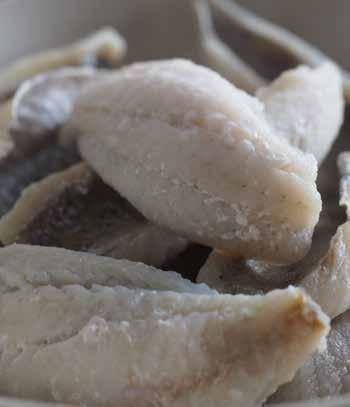
Coming crises
Oceana faces a big battle as it pushes for traceability and science-based management in Mexico’s fisheries. “We have a fisheries sector that has been the victim of neglect of a lot of governments and a lot of administrations for a long time,” Zapata said.
Despite the crucial role healthy oceans play in Mexico’s seafood, tourism and real estate sectors, the country is ill-prepared for the challenges of a swiftly changing climate, Zapata noted. The disorganization — and at times, corruption — of the country’s fisheries agencies means that rules and enforcement aren’t equipped to deal with upcoming crises like mass fish migration and rapidly shifting habitats.

“
People are very unsurprisingly and correctly concerned about being defrauded. People were not amused when they were being given shark and they didn’t ask for shark. ”

This lack of preparation is typified along the Caribbean coast, in places like Tulum and Cancún, where a sudden plague of sargassum seaweed is befouling beaches and driving tourists away. Though sargassum is a natural part of the ecosystem, it’s now exploding in never-before-seen abundance. Wind and waves push floating mats of algae to the coast, where it piles in smelly, metersthick mounds and stains the water an unsightly brown.
No one knows exactly what’s behind the bloom, but as sargassum is a warmth-loving species, scientists suspect global warming is at least in part to blame. So far, Zapata said, efforts have focused too much on cleanup and disposal, and not enough on figuring out why the problem has gotten so bad and how the sargassum can be stopped at its source.
Buyer beware: In Cancun, that grouper is probably Asian catfish.
Coming crises continued Oceana, however, is equipped to take on Mexico’s current and coming problems. It’s one of the few nonprofit organizations dedicated to public policy in Mexico, and the only one dedicated to ocean policy, Zapata said. Years of experience with marine policy, science, advocacy and litigation in other countries — and on the same issues that Oceana is tackling in Mexico — mean that the team has plenty of expertise and case studies to draw on. One day, the country’s fisheries could be as transparent as the waters off Cancún.



Mexico’s murky waters
Sargassum seaweed is plaguing Mexico’s east coast.

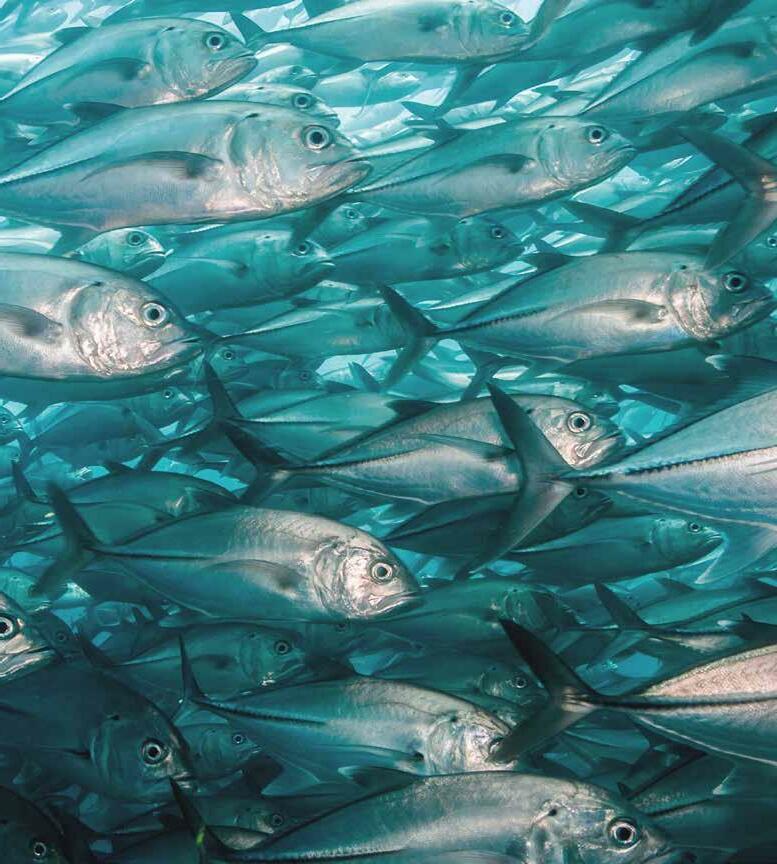 Bigeye trevally, known for forming impressive schools, are often important in artisanal fisheries.
Bigeye trevally, known for forming impressive schools, are often important in artisanal fisheries.
Plastic conquered the planet. Now the planet is fighting back.
Plastic devastates marine life and swamps recycling efforts. Oceana and a global network of anti-plastic advocates are now fighting to stop plastic at the source.
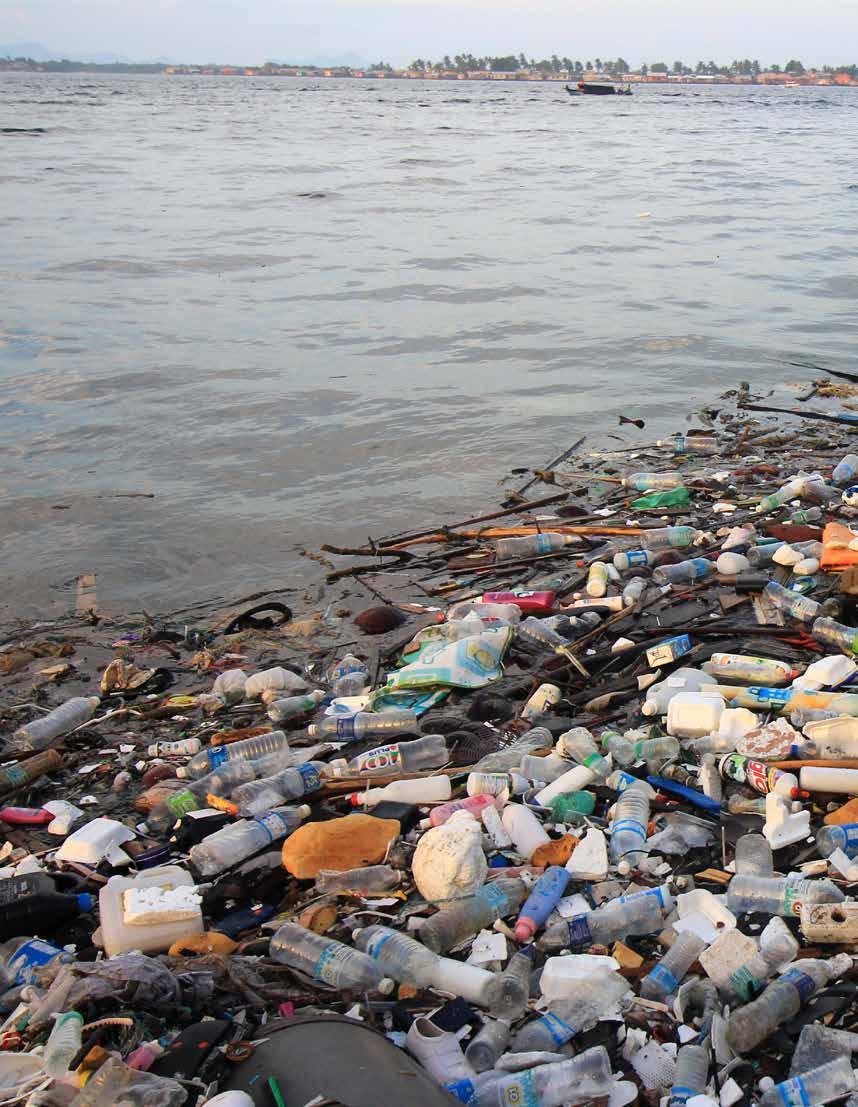
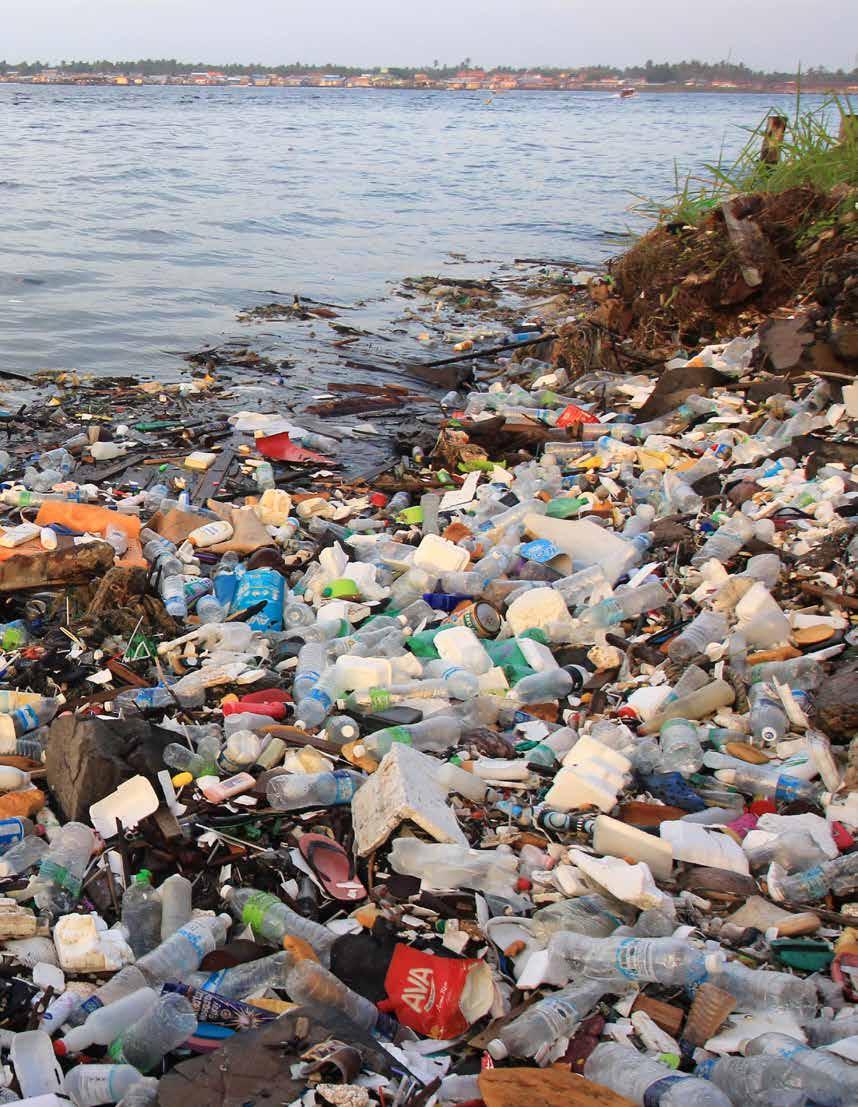 Global industries have churned out over 8.3 billion tons of plastic since 1950.
Global industries have churned out over 8.3 billion tons of plastic since 1950.
Bangka Island, off northern Sulawesi in Indonesia, would be paradise, if not for the plastic. Single-use bags and disposable diapers tangle in thousandyear-old corals. High tide leaves behind a line of plastic bottles, cups and straws on the white, flour-soft beaches. The sand is a confetti of plastic flakes and crumbled polystyrene.
Bangka Island is one of the countless casualties of our love affair with plastic. Since 1950, over 8.3 billion metric tons of plastic have flooded the planet. Since the material takes centuries to decompose, every toothbrush and coffee stirrer is still with us, in one form or another.

The food, beverage and packaging companies behind this plastic tsunami have, for decades, propped up recycling as a “get out of jail free” card, letting the world make and buy as much plastic as it wants. But the global torrent of dirt-cheap plastic has far exceeded our capacity to recycle, inundating waste-management systems that can’t handle the volume.
The problem is only going to get worse, warned Jackie Savitz, Oceana’s Chief Policy Officer. Global plastic production is projected to triple by 2050. “The way the ocean looks now will seem good to us in the future,” Savitz said.
20
Over 8.3 billion metric tons of plastic have flooded the planet since the 1950s.
Because plastic takes centuries to degrade, all of the plastic ever produced is still with us, in one form or another.

Sea turtles often mistake plastic bags for jellyfish, one of their main food sources.

Plasitic bags can block an animal’s stomach and starve it.
A treacherous tide
By now, it’s no secret that plastic pollution is catastrophic for nature. The oceans are hardesthit, with one dump truck’s worth of plastic entering the sea every minute — 8 million metric tons a year.

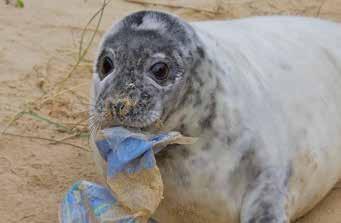
The most visible casualties are the whales, sea turtles and seabirds that wind up starved, suffocated, drowned or lacerated by plastic junk. But the most worrisome dangers of plastic might be the ones we can’t see.
As plastic degrades, it shreds into ever-smaller flecks and fibers that range in size from a grain of rice to one-billionth of a meter. These “microplastics” essentially never disappear, and have been found everywhere researchers have looked: not only in marine creatures like fish and mussels, but also in salt, honey, beer, dust, soil, bottled water, tap water and rainwater.
Scientists don’t yet have a full picture of what microplastics do to our bodies, but the early results aren’t good. Microplastics can pass from a fish’s food into its organs, where it can cross the blood-brain barrier and trigger strange behaviors.
Microplastics leach chemicals linked to cancer, heart disease, obesity, and reproductive and neurological disorders. Plastic also acts like a magnet for other dangerous compounds in the environment like PCBs and cadmium. Many researchers suspect that chemicals found in and on plastics are behind men’s declining sperm counts and the dismal reproductive success of certain killer whale populations.
22
Plastic pollution poses a serious threat to seabirds.
Forgotten, but not gone
On Bangka Island, volunteers with a local nonprofit are able to clean just a fraction of the plastic that winds up on the island — which itself is just a sliver of the 1.3 million tons of plastic that pour into Indonesia’s waters every year. The volunteers spend several hours each day scouring the beach to collect, wash and sort plastic and other trash, which is periodically shipped off to be recycled. Because recycling facilities are so rare in Indonesia, Bangka’s reclaimed plastic has to be shipped over 1,000 miles to the city of Surabaya to be recycled.
Overall, only 9 percent of plastic has ever been recycled. The rest winds up dumped in landfills, burned, or washed into the ocean. This might come as a surprise to

residents of wealthy nations where recycling programs are ubiquitous. But these programs hide a grim reality: Most plastic is shipped to countries with lax regulation and dirt-cheap labor — the only places where plastic recycling can turn a profit, even if razor-thin.
Until recently, almost everything chucked in recycling bins in North America, Europe and Australia made its way to China. We sent not only more-valuable plastics like water bottles and detergent jugs, but also millions of tons of unrecyclable filth, from gunk-encrusted yogurt cups to dirty diapers. China, however, is struggling with its own trash catastrophe. Last year it enacted a near-total ban on contaminated “foreign garbage.” Malaysia was the next destination, until it too was overwhelmed.
SUMMER 2019 | Oceana.org23
Only 9% of plastic has ever been recycled.
Microplastics are a poorly understood threat to human and animal health.
Forgotten, but not gone (continued)
Our “recycling” is now often just burned or landfilled at home. If it does get sent abroad, it usually winds up in last-resort spots like Surabaya, where recyclers sort out the highest-value plastic and then dump the remainder for informal trash-pickers. Anything that can’t be recycled is piled in illegal landfills, burned (releasing dioxins and other highly poisonous compounds), or simply tossed in fields, forests or roadsides. When the rainy season comes, it’s washed into rivers and out to sea — hardly the result most envision when they toss a bottle in the recycling bin.
Oceana — along with other advocacy groups, scientists and governments — is now taking aim at plastic before it’s even manufactured. The main target is packaging, which makes up 40 percent of all plastic produced worldwide. Bans and taxes on local, state and national levels have shown that action against throwaway junk can have swift, pronounced results.
In Kenya, for example, a strict plastic bag ban has led to visibly cleaner landscapes. In the United States, bag bans have also dramatically reduced bag litter in cities and states across the country.
Pollution solution
“There’s really no way we as individuals can avoid plastics in our lives,” Savitz said. It wraps just about every consumer product out there. While plastic-free lifestyles have become trendy in some circles, going zeroplastic requires time, money and consumer acrobatics. “Companies have made avoiding plastic unattainable for most people,” Savitz added.
As public sentiment turns against plastic, the companies responsible for the most common plastic pollutants — single-use bottles, containers, straws, wrappers, bags and so on — are scrambling to stave off a PR nightmare. “A lot of these companies see the writing on the wall,” said Savitz. “They know they’re in trouble.” But with the volume of plastic ever increasing, there’s no way these types of proposals could work, Savitz added. “They’re basically empty promises being made for public relations reasons.”

But piecemeal bans on bags and straws can only go so far. That’s why countries are unveiling comprehensive legislation to take on disposable plastics. In 2018, the EU announced a phase-out of a range of single-use plastics by 2021, with Canada following suit with similar proposed legislation in June.
Oceana was behind Peru’s announcement last December of a new law regulating throwaway plastics, which bans single-use plastics from sensitive areas like beaches and national parks, taxes bags, and limits the manufacture and use of a broad swath of disposable plastics. Oceana worked with allies in Congress to present one of the more than 20 plastics bills, and provided technical support during the legislative process to reach consensus and approve the law in record time.
24
Packaging makes up 40% of all plastic produced worldwide.
At the same time, Oceana launched a massive communications effort to build support for the law. The organization even partnered with top chefs for the “I don’t want this in my ceviche” campaign, highlighting the dangers of microplastics in Peru’s beloved national dish.
Carmen Heck, Oceana’s plastics campaign manager in Peru, said the new law is “a very important step that is already generating changes,” but cautioned that “there is still a long way to go to ensure Peru’s oceans are free of plastics.”
Peru isn’t the only country where Oceana is battling the single-use scourge. In Chile, five senators announced a plan to limit and regulate the production of disposable plastics in May. The plan was based on a detailed analysis by Oceana and its partner Plastic Free Chile. And in the United States, Oceana will begin pushing companies and institutions to offer plastic-free choices, whether in hotel rooms, supermarket aisles or school cafeterias. This would take the onus off consumers and put it on the manufacturers and retailers responsible for churning out throwaway plastics.
Biodegradable utensils and packaging are one alternative to plastic, though they are not without their drawbacks.

A $200 billion bet
As anti-plastic sentiment picks up steam, it’s tempting to think that we’re making less of the stuff. We’re not. Globally, plastic production is increasing each year. And the battle is set to get worse.
The supply of cheap natural gas from shale deposits in the United States is surging at the same time as the usually insatiable demand for fossil fuels is slowing. The oil and gas industry, saddled with a glut of natural gas, and perhaps nervous that the world might take decisive climate action, is betting its future on plastic.
“Their only growth opportunity is to foist more plastics on us,” Savitz said.
Since 2010, oil and gas companies have poured $186 billion dollars into new “cracking” facilities that produce plastic resins and other petrochemicals. Experts warn that these investments may be locking in colossal increases in plastic manufacturing at the very time we need to be rolling it back.
If this comes to pass, it would spell disaster for the ocean and the climate. Creating one ton of plastic emits nearly two tons of greenhouse gases. Plastic currently accounts for 3.8 percent of global greenhouse gas emissions, double that of aviation. By mid-century, the emissions from plastics production are projected to reach nearly one-sixth of total emissions, sinking any shot we have at preserving a livable climate.
“We need to take action quickly and decisively,” Savitz said. “Policy and advocacy are our best chance to stop a permanent crisis for the ocean and climate.”
In the meantime, on Bangka Island, each high tide brings a fresh harvest of crumpled containers and barnacleencrusted bottles. And each day volunteers leave the palm-fringed strip of beach clean, if only for a few hours.

26
Only once global plastic production is significantly scaled back can recycling and cleanup efforts have a lasting impact.
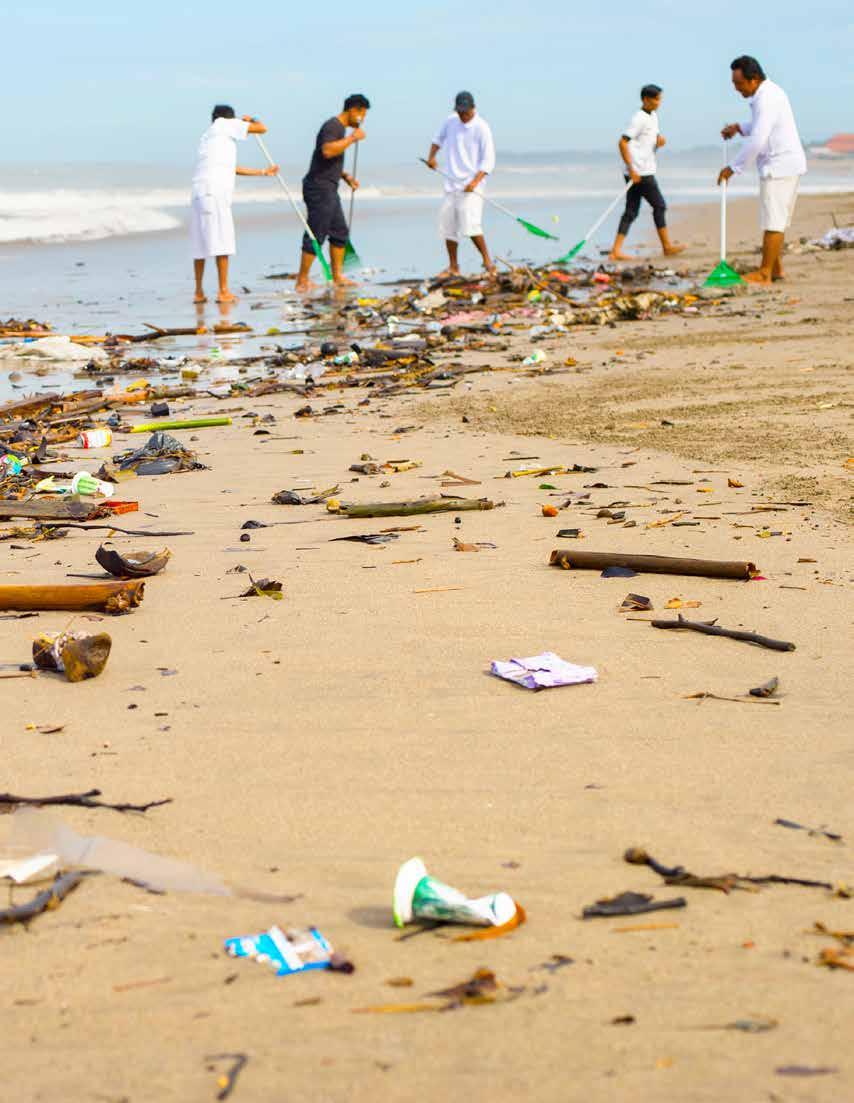
2018-2019 Victories
2019 | June
• Canada passes new Fisheries Act: A historic win for Canada’s oceans
• Canada bans shark fin trade, first of G20 countries May
• Chile publishes vessel tracking data for fishing fleet, promoting transparency at sea April
• New York prohibits offshore drilling
• Canadian government bans industrial activity in Marine Protected Areas March
• Oceana wins lawsuit to protect vulnerable dusky sharks
• Canada creates Banc-des-Américains Marine Protected Area February
• Spain creates the second-largest marine national park in the Mediterranean January
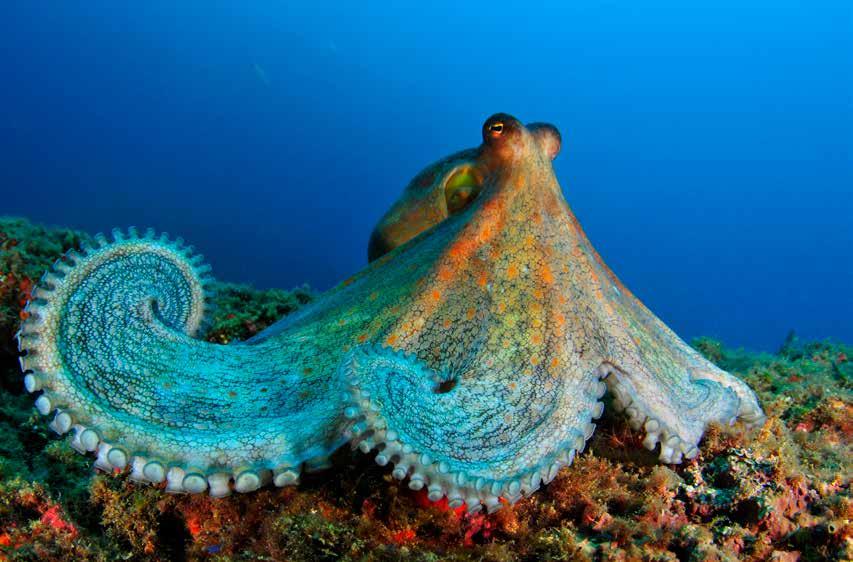
• Chile passes one of world’s strongest laws against illegal fishing
2018 | December
• The Philippines protects 276,000 square kilometers of ocean from bottom trawling
• Peru passes law to ban plastic bags and reduce use of plastics in protected areas
October
• California stops use of destructive fishing gear that kills dolphins, turtles and sharks September
• Brazil stops destructive bottom trawling in 13,000 square kilometers of ocean that is home to endangered species June

• Malta expands habitat protections in the Mediterranean, protects 35 percent of its waters May
• Brazil introduces first-ever management rules for tainha, begins science-based management of fisheries
• Philippines creates Philippine Rise protected area and protects 300,000 hectares as a no-take zone to safeguard unique habitat, corals and more
28
© Oceana/Carlos Minguell
Supporter Spotlight
Diane Lane: “We all need the ocean to live”
New York City is where Oscar-nominated actress and longtime Oceana supporter Diane Lane grew up and first discovered her love of the water. Nearby Jones Beach, Lane said, was a beloved urban refuge.

“Jumping in those waves is my happiest childhood memory,” she said. “I joined Oceana because I was inspired to fight back against apathy and feeling overwhelmed. I am energized and hopeful, despite the odds, because we have awakened from our sleep and denial about our planet’s predicament.”
In recognition of Lane’s dedication to preserving the world’s oceans, she will be honored at Oceana’s New York Gala on September 10. The theme of this year’s event is “the crisis of ocean plastic” – an issue Lane is all too familiar with, having spoken out about it long before the media buzz surrounding plastic straws and shopping bag bans.
In 2011, Lane addressed the crowd at Oceana’s annual “Sea Change” event in Santa Monica. Back then she told the crowd, “If we fail to save the oceans from ourselves, it would be a defeat on a scale that makes one shudder to envision. It touches us all eventually, from our health to our economy to our soul. What are we going to tell our children? That we gave up? We left it to the profiteers to fix? That we found the problems too complex or rife with international brinkmanship?
“Oceana uses the cumulative wisdom of science and whistle blowers to track the politics and policies that got us to this point. Oceana is where I turn for leadership in the changes that must be made to save our oceans. But it is up to us to be pro-active, ambitious, far-reaching, demanding the changes in policies, lobbying for tougher laws, innovatively improving equipment and enforcing these changes with some teeth.”
Indeed, Lane’s activism and lobbying efforts have made her a valuable voice to have on our side. She has used her platform to educate others about the many issues plaguing our ocean.
In the summer of 2018, she joined Oceana in Washington, DC to urge members of Congress to push for the passage of the Shark Fin Sales Elimination Act, which would make it illegal to possess, buy or sell shark fins. Galvanized by a grassroots campaign led by Oceana, Canada passed a similar ban this July. The U.S. legislation is still advancing through Congress.
During that same visit to DC, Lane also addressed her opposition to the practices of both offshore drilling and
other leaders.
For Lane, taking care of our oceans is not just a matter of conservation. It’s also about self-preservation. “We are the hope of the sea and her inhabitants…
We are their voice. Guardian. Advocate. Ally. Soldier. Parent. Politician. Lobbyist. Nurse. We go out of our way, for our own future, the future generations, and we go that extra mile for our mother, the ocean. Without her fertility we lose our collective soul.
What wouldn’t we do for our own mother?”
Indeed.
Diane Lane made her film debut opposite Sir Laurence Olivier in “A Little Romance.” She has received “Best Actress” honors by the New York Film Critics and National Society of Film Critics, and Academy Award, SAG and Golden Globe nominations for her starring role in “Unfaithful”; a Golden Globe nomination for “Under the Tuscan Sun”; Emmy, Golden Globe and SAG Award nominations for her leading role in HBO’s “Cinema Verite”; an Independent Spirit Award nomination for “A Walk on the Moon”; and an Emmy nomination for “Lonesome Dove.” She recently received glowing reviews for her co-starring role in the final season of Netflix’s “House of Cards” and has just wrapped production on the upcoming film “Let Him Go” with co-star Kevin Costner.
SUMMER 2019 | Oceana.org29
© Mark Seliger
seismic airgun blasting at a meeting arranged by Oceana with the Bureau of Ocean Energy Management’s Acting Director, Chief of the Office of Public Affairs and numerous
Dr. Pauly
What aquaculture can and cannot do
Following my frequent public lectures on the parlous states of fisheries in the world, I invariably get the question, “Is aquaculture not the answer to all these problems?” This sounds reasonable: If fish populations dwindle in the wild, why not grow fish in coastal areas, or on land, or in ponds or tanks? After all, this is what we do with plants and agriculture.
American journalist H.L. Mencken is supposed to have said: “For every complex problem there is an answer that is clear, simple and wrong.” This is a good example of that. Aquaculture (including mariculture)
actually consists of two subsectors that are as distinct from each other as growing vegetables and raising cattle. I call these two sectors “Aquaculture A” and “Aquaculture B,” with the former being the farming of mussel, oyster, clam and other animals that feed on microscopic algae (i.e. the grass of the sea), and the latter being the raising of carnivorous fish, such as salmon, seabass and groupers.
While the former do not need to be fed animal protein any more than carp, tilapia and other freshwater herbivores, marine carnivores must have animal proteins in the
diet they are given. They get these animal proteins in the form of fishmeal and fish oils, which are made by grinding up millions of tons of sardine, anchovies, herring, mackerel and other fish that are not only perfectly edible, but favored in Europe as well as African and Asian countries, where they often are the only “meat” many people can afford.
Thus, when we speak of “us” needing to increase aquaculture production so “we” have enough fish in the future, the question is who is “us” and “we.” If “we” pertains to the U.S., Canada and Europe, then yes, “we” can increase our
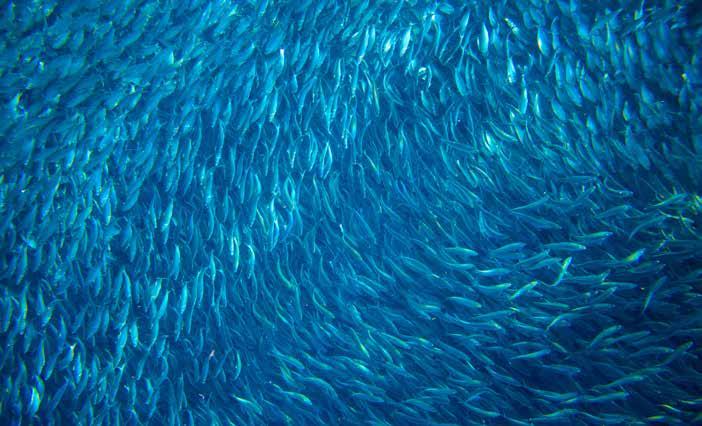
30
supply of salmon for our sushi and other delicacies. If “we” are people throughout the world, then no, the more carnivorous fish we raise, the less fish there will be both in the water and in the diets of poorer people.
That aquaculture B consumes rather than produces fish is not intuitive. It’s similar to the fact that air conditioners actually warm the world (when accounting for not only the space they cool, but for the space that gets the waste heat), or that our discarded plastic bags do not actually vanish into thin air when we “recycle” them.
of species that has so far remained underexploited in the ocean, which is the reason why yellowfin and other tunas are still able to find some food. However, mesopelagics will probably be turned into fishmeal, as well.
The reason for this fishmeal “hunger” is that soybean meal, long touted as a replacement for fishmeal, cannot fully substitute for it; fish fed soymeal get sick without fishmeal and/or fish oil, and they also taste like tofu. Thus, while fish feed may contain more soymeal than before, the increased
Thus, fisheries will not be replaced by aquaculture (at least not by Aquaculture B, the one we love in “our” countries). Rather, Aquaculture B, in search of more and more feedstock, is currently exploiting Antarctic krill — the food of penguins and marine mammals — and will soon target tiny lanternfish and other mesopelagic fishes found in shallow waters at night (when tuna feed on them), and at depths of up to 3,000 feet during the day. These fish may be the last group
production of Aquaculture B still raises demand for fishmeal.

In the meantime, let’s be wary of people who tell us that aquaculture will solve our fisheries problems. They tend to forget that aquaculture uses an increasing fraction of the limited fishmeal obtained from fisheries and will destroy, in order to grow, the food base of our remaining wild fish — most notably by extracting krill and mesopelagic fishes.
Figure 1. Trends in fisheries catches and aquaculture production, 1950-2014. The black lines are based on marine and freshwater fisheries catch and aquaculture production data from the Food and Agriculture Organization of the United Nations (FAO), as reported by its member countries, and includes edible algae (mainly from China). The trend in dark blue is based on freshwater catch data from FAO, plus marine catch data “reconstructed” by the Sea Around Us, (see www.seaaroundus.org) minus discarded fish (also not included in the FAO data) and the fish used for fishmeal and for aquaculture (to avoid double counting), i.e. 70 percent in the 2010s, declining to 50 percent in the 1980s. The light blue trend shows aquaculture production data from FAO, excluding edible algae.

SUMMER 2019 | Oceana.org31
Dr. Daniel Pauly is the founder and director of the Sea Around Us project at the University of British Columbia’s Institute for the Oceans and Fisheries, and is a member of the Oceana board.
Sea Song
On April 9, over 231 guests attended Sea Song, Oceana’s first major fundraiser in Mexico City to celebrate the first anniversary of Oceana’s Mexican office. The event took place at the Auditorio Nacional, where the audience sat on the stage and the performers appeared in the surrounding seating area, making for an unusual and magical evening. Guests were welcomed by board member Gaz Alazraki and musician and actor Miguel Bosé. Comedian Sofia Niño de Rivera emceed the evening introducing compelling speeches by Ted Danson, David Rockefeller, Andy Sharpless, and Pedro Zapata. The evening was capped with intimate,


Contramar, Buchanan’s’18, Alazraki Entertainment, Canon, Ambienta, Seitrack, Complejo Cultural Universitario, OSBUAD, Once-Once, Yamaha, Flower Corner, Mobility ADO, Canon/Print Spot, BUAP, Monte Xanic and the Auditorio Nacional.
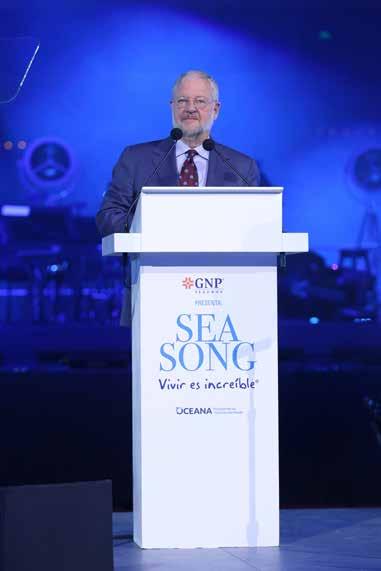
32
Rafael Dominguez, Maria José Pérez Simón, and Jose Antonio Pérez Simón
Benny Ibarra and Ximena Sariñana performing
Events
David Rockefeller Jr.
© Eduardo Aragon
All photos by © Eduardo Aragon
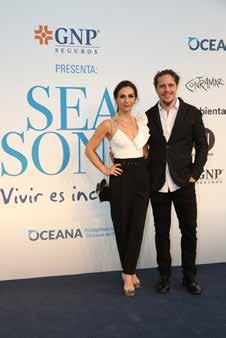





SUMMER 2019 | Oceana.org33
Maria José Pérez Simón and Family
Elías Sacal, Susan Rockefeller, and David Rockefeller Jr.
Gaz Alazraki and Miguel Bosé
Gaz and Vivian Alazraki
Pedro Zapata, Vice President of Oceana in Mexico
Events
María Asunción Aramburuzabala and her family
© Eduardo Aragon
Fin Win Rockfish

34 © Shutterstock/Casanisa
Chili pepper, yellowtail and canary rockfish have names as colorful as their scales. These fish are part of a group of dozens of rockfish species that dwell along the cold, rocky seafloor off California’s coastline. Many rockfish populations are doing so well that fisheries managers recently doubled or even tripled the amount that fishermen can catch.
But California’s rockfish weren’t always booming. In the early 2000s, after decades of fisheries mismanagement, fishing had stripped California’s rocky reefs of much of their rockfish. Some species, like bocaccio, had plummeted so much that they were candidates for the endangered species list.
In the late 1990s Oceana, in an earlier incarnation called the American Oceans Campaign, won a lawsuit against the government for failing to enforce key rules protecting rockfish. Oceana then partnered with officials, fishing interests and other environmental organizations to rebuild rockfish populations. The organization took the lead on habitat protections, pushing for key rockfish areas to be protected from bottom trawls, a type of fishing gear notorious for destroying the delicate corals, sponges and other underwater features that make for rich rockfish habitat.
Now, thanks to Oceana advocacy, 275,000 square miles of seafloor habitats in California, Oregon and Washington have been protected from bottom trawling. Many of California’s once-decimated rockfish have since bounced back, bringing in an estimated 900 new jobs and $60 million in additional income. For fans of California’s colorful bottom-dwellers — and their delicious fillets — that’s tasty news indeed.
Mark Bittman’s Rockfish Fillets in Sweet Soy Marinade
Makes 4 servings
1 to 1 ½ pounds rockfish fillets (about 4), skin on or off
½ cup sesame seeds 1 teaspoon sesame oil
¼ cup high-quality soy sauce
1 tablespoon peeled and finely minced or grated fresh ginger
½ cup minced scallion, both green and white parts
1 teaspoon minced garlic 1 tablespoon dry sherry 1 tablespoon honey or sugar
From Mark Bittman’s Fish: The Complete Guide to Buying and Cooking
Instructions
Toast the sesame seeds over medium heat in a dry skillet, shaking occasionally, until they brown and become fragrant, 3 to 5 minutes. Cool, then put them in a plastic bag and crush them with a rolling pin. Place in a large bowl with all the marinade ingredients (reserve half the scallions) and the fish. Marinate for as little as 5 minutes and as long as 1 hour.
Preheat the broiler, then place the fish on a rack on a baking sheet. Pour the remaining marinade over the fish and broil until lightly browned on top, 5 to 8 minutes. The fillets will be white and firm, and a thin-bladed knife will pass through them with little resistance. Garnish with the reserved scallions and serve immediately, with white rice.
SUMMER 2019 | Oceana.org35
Mexican photographer Pablo Zapata Aramburuzabala captured this humpback whale swimming with her calf on Silver Bank, 90 kilometers north of the Dominican Republic. During the breeding and calving season, Silver Bank hosts around 7,000 whales, making it one of the planet’s largest gatherings of humpbacks.
Many humpback populations have bounced back from near-extinction after an international whaling moratorium was instituted in 1985. There are now an estimated 10,800 whales in the West Indies alone — an astounding recovery that proves science-led conservation works.

36

SUMMER 2019 | Oceana.org37 ©
Pablo Zapata

Global | Washington, D.C. Europe | Brussels | Copenhagen | Madrid | Geneva | London South America | Brasilia | Santiago | Lima Asia | Manila North America | Belmopan | Ft. Lauderdale | Juneau | Mexico City | Monterey | New York | Portland | Toronto Go to Oceana.org and give today. 1025 Connecticut Ave NW, Suite 200 Washington, DC 20036 USA phone: +1.202.833.3900 toll-free: 1.877.7.OCEANA You can help Oceana fight to restore our oceans with your financial contribution. Call us today at 1.877.7.OCEANA, go to our website www.oceana.org/give and click on “give today” or use the envelope provided in this newsletter. You can also invest in the future of our oceans by remembering Oceana in your will. Please contact us to find out how. All contributions to Oceana are tax deductible. Oceana is a 501(c)(3) organization as designated by the Internal Revenue Service. Oceana’s accomplishments wouldn’t be possible without the support of its members. Nudibranchs are marine slugs that often sport eye-catching colors
©Oceana/DanielOcampo


























 Bigeye trevally, known for forming impressive schools, are often important in artisanal fisheries.
Bigeye trevally, known for forming impressive schools, are often important in artisanal fisheries.

 Global industries have churned out over 8.3 billion tons of plastic since 1950.
Global industries have churned out over 8.3 billion tons of plastic since 1950.




























